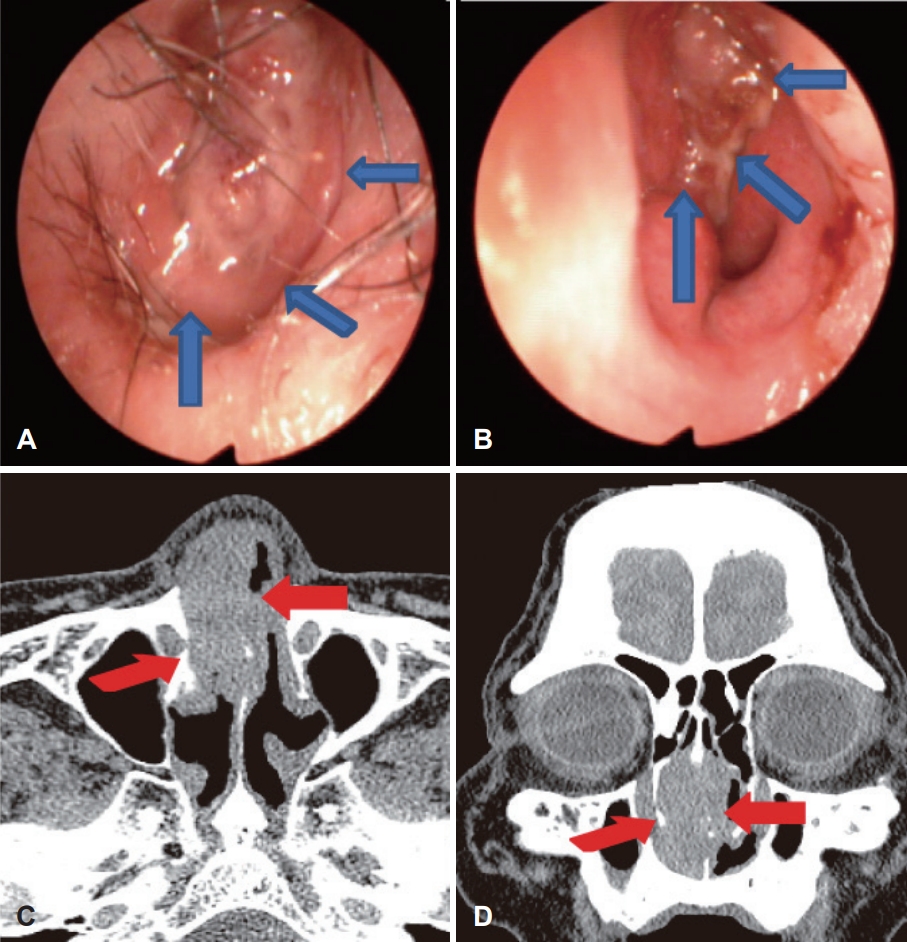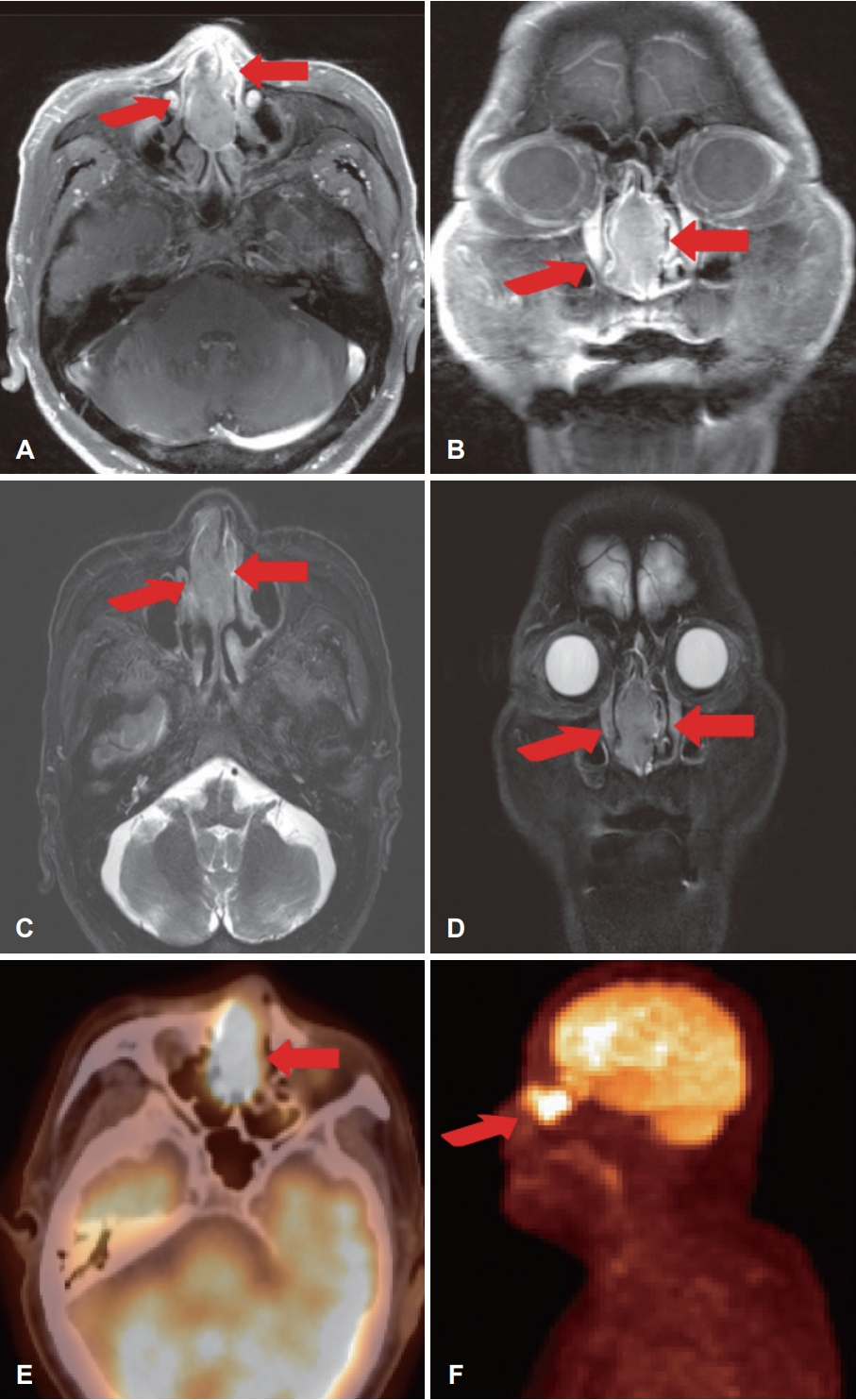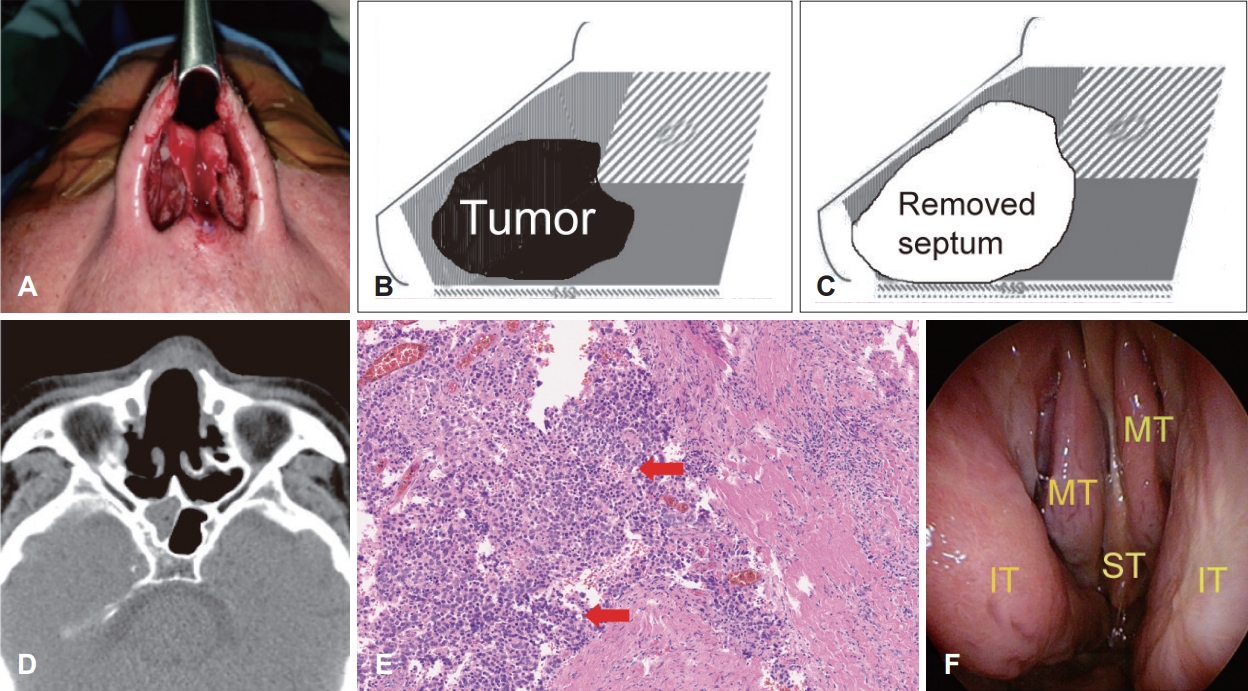 |
 |
AbstractPrimary tumors arising solely from the nasal septum are quite unusual. Moreover, malignant tumors arising from the nasal septum are rare and represent less than 9% of sinonasal malignancies. Of all reported cases of nasal septum carcinoma, squamous cell carcinoma is the most common type. Due to the rare prevalence, its clinical course and prognosis are not well established. In this article, we report a case of a 79-year-old male with nasal obstruction. Endoscopic examination showed an exophytic mass obstructing the right nasal cavity accompanied by polypoid mass in the left nasal cavity. Punch biopsy confirmed the diagnosis of squamous cell carcinoma by histopathology. Radiologic evaluation showed a large nasal cavity mass involving the nasal septum. The tumor was removed using the external rhinoplasty approach with a large septal resection, saving the nasal keystone area and the columella to prevent the external nose deformity.
м„ң лЎм•…м„ұмў…м–‘мқҙ 비мӨ‘кІ©м—җм„ң л°ңмғқн•ҳлҠ” кІҪмҡ°лҠ” л§Өмҡ° л“ңл¬јл©° 비л¶Җ비강м—җм„ң л°ңмғқн•ҳлҠ” м•…м„ұмў…м–‘мқҳ 9%лҘј м°Ём§Җн•ңлӢӨ[1,2]. мөңк·ј 10л…„ лҸҷм•Ҳ 비мӨ‘кІ©м—җм„ң л°ңмғқн•ң м–‘м„ұкіј м•…м„ұмў…м–‘мқҳ л№ҲлҸ„м—җ лҢҖн•ң м—°кө¬кІ°кіјм—җм„ң к°ҖмһҘ нқ”н•ң м•…м„ұмў…м–‘мқҖ м•…м„ұнқ‘мғүмў…, plasmacytoma, м „мқҙм•”мқҙлқјкі ліҙкі н•ҳкі мһҲлӢӨ[3]. 32мҳҲлҘј 분м„қн•ң м—°кө¬кІ°кіјм—җм„ңлҠ” м•…м„ұнқ‘мғүмў…, мғҳм•”мў…(adenocarcinoma), нҺёнҸүмғҒн”јм•”, м—°кіЁмңЎмў…(chondrosarcoma) к°Ғк°Ғ 1мҳҲм”© ліҙкі лҗҳм—ҲлӢӨ[4]. мөңк·ј 10л…„к°„ 비мӨ‘кІ©м—җм„ң л°ңмғқн•ң м•…м„ұмў…м–‘ 14мҳҲлҘј 분м„қн•ң ліҙкі м—җм„ңлҠ” 6мҳҲк°Җ нҺёнҸүмғҒн”јм•”мқҙм—Ҳкі , м•…м„ұнқ‘мғүмў…, нҳҲкҙҖмЈјмң„м„ёнҸ¬мў…(hemangiopericytoma), мғҳм•”мў…, мғҳлӮӯм•”мў…(adenoid cystic carcinoma), нҡЎл¬ёк·јмңЎмў…(rhabdomycosarcoma) мҲңмқҙм—ҲлӢӨ[5]. мқҙмҷҖ к°ҷмқҙ 비мӨ‘кІ©м—җм„ң л°ңмғқн•ң нҺёнҸүмғҒн”јм•”мқҳ л°ңмғқл№ҲлҸ„лҠ” л§Өмҡ° л“ңл¬јлӢӨ. нҺёнҸүмғҒн”јм•”мқҖ л¬јлЎ лӢӨлҘё м•…м„ұмў…м–‘мқҳ л№ҲлҸ„лҸ„ м Ғм–ҙ м№ҳлЈҢл°©лІ•м—җ лҢҖн•ң кІ°кіјк°Җ лҸ„м¶ңлҗҳм–ҙ мһҲм§Җ м•Ҡм•„м„ң м •нҷ•н•ң м№ҳлЈҢлІ•мқҖ нҳ„мһ¬к№Ңм§Җ м •лҰҪлҗҳм–ҙ мһҲм§Җ м•ҠлӢӨ.
к·ёлҹјм—җлҸ„ л¶Ҳкө¬н•ҳкі л№„мӨ‘кІ© м•…м„ұмў…м–‘мқҳ к·јліём Ғмқё м№ҳлЈҢл°©лІ•мқҖ 비강 лӮҙм—җм„ң л°ңмғқн•ң м•…м„ұмў…м–‘мқҳ м№ҳлЈҢлІ•м—җ мӨҖн•ң мҷёкіјм Ғ мў…м–‘м Ғм¶ңмҲ кіј мҲ нӣ„ л°©мӮ¬м„ м№ҳлЈҢмқҙлӢӨ. мөңк·јм—җлҠ” 비мӨ‘кІ©м—җм„ң л°ңмғқн•ң м•…м„ұмў…м–‘мқҳ м ңкұ°м—җлҠ” лӮҙмӢңкІҪмқ„ мқҙмҡ©н•ң ліҙмЎҙм Ғ мҲҳмҲ мқҙ л§Һмқҙ м Ғмҡ©лҗҳкі мһҲлҠ” мӢӨм •мқҙлӢӨ. к·ёлҹ¬лӮҳ мҷёкіјм Ғ м ‘к·јлІ•мқҖ 비мӨ‘кІ©м—җ л°ңмғқн•ң мў…м–‘мқҳ мң„м№ҳ л°Ҹ нҒ¬кё°м—җ л”°лқјм„ң кІ°м •лҗңлӢӨкі ліҙкі н•ҳмҳҖлӢӨ[6].
ліё мҰқлЎҖлҠ” 비мӨ‘кІ©м—җм„ң л°ңмғқн•ң нҺёнҸүмғҒн”јм•”мқҙ 비мӨ‘кІ©мқҳ м—°кіЁл¶Җмң„мҷҖ кіЁл¶Җмң„лҘј л„“кІҢ м№ЁлІ”н•ҳмҳҖкё° л•Ңл¬ём—җ м•”мў…мқ„ 충분нһҲ м ңкұ°н• мҲҳ мһҲлҸ„лЎқ мҲҳмҲ мӢңм•јлҘј нҷ•ліҙн•ҳкё° мң„н•ҙ 비мҷём ‘к·јлІ•мқ„ мқҙмҡ©н•ҳм—¬ м ңкұ°н•ң 1мҳҲлҘј кІҪн—ҳн•ҳмҳҖкё°м—җ л¬ён—Ң кі м°°кіј н•Ёк»ҳ ліҙкі н•ҳкі мһҗ н•ңлӢӨ.
мҰқ лЎҖ79м„ё лӮЁмһҗ нҷҳмһҗк°Җ 1лӢ¬ м „л¶Җн„° мӢңмһ‘лҗң мҡ°мёЎ 비нҸҗмғүмқ„ мЈјмҶҢлЎң лӮҙмӣҗн•ҳмҳҖлӢӨ. кё°м Җм§Ҳнҷҳмқҙ м—ҶлҠ” нҷҳмһҗмҳҖмңјл©°, 비лӮҙмӢңкІҪ кІҖмӮ¬м—җм„ң мҡ°мёЎ 비강 лӮҙм—җм„ң л¶Ҳк·ңм№ҷн•ң н‘ңл©ҙмқ„ к°Җм§Җкі мһҲлҠ” м„ нҷҚмғү мў…л¬јмқҙ к°Җл“қ мұ„мҡ°кі мһҲмңјл©° мўҢ측비강м—җм„ңлҠ” мў…л¬јмқҙ н•ҳ비갑к°ңмқҳ н‘ңл©ҙк№Ңм§Җ м ‘мҙүлҗҳм–ҙ мһҲлҠ” м–‘мғҒмңјлЎң кҙҖм°°лҗҳм—ҲлӢӨ(Fig. 1A and B). мў…м–‘мңјлЎң мқён•ң мЈјмң„ кіЁнҢҢкҙҙмқҳ м •лҸ„лҘј м •нҷ•н•ҳкІҢ нҢҢм•…н•ҳкё° мң„н•ҳм—¬ мҙ¬мҳҒн•ң л¶Җ비강 м»ҙн“Ён„°лӢЁмёөмҙ¬мҳҒм—җм„ңлҠ” 비мӨ‘кІ©мқҳ м—°кіЁл¶Җ분мқ„ мЈјлЎң м№ЁлІ”н•ҳлҠ” мҶҢкІ¬мқҙ кҙҖм°°лҗҳм—Ҳмңјл©°, 비мӨ‘кІ©мқҳ нӣ„л°ҳл¶ҖмҷҖ мғҒл¶ҖлҘј м°Ём§Җн•ҳлҠ” кіЁл¶Җм—җм„ңлҠ” кіЁнҢҢкҙҙ л°Ҹ м№ЁлІ”мҶҢкІ¬мқҖ кҙҖм°°лҗҳм§Җ м•Ҡм•ҳлӢӨ(Fig. 1C and D). мў…м–‘мқҳ м •нҷ•н•ң м№ЁлІ”л¶Җмң„лҘј нҢҢм•…н•ҳкё° мң„н•ҳм—¬ мӢңн–үн•ң л¶Җ비лҸҷ мһҗкё°кіөлӘ…мҳҒмғҒкІҖмӮ¬м—җм„ңлҠ” gadoliniumмқ„ мӮ¬мҡ©н•ң T1 к°•мЎ°мҳҒмғҒм—җм„ң к· м§Ҳн•ҳкІҢ мЎ°мҳҒмҰқк°•лҗҳлҠ” мў…л¬јмқҙ 비мӨ‘кІ©мқ„ м№ЁлІ”н•ҳкі мһҲлҠ” мҶҢкІ¬мқҙ кҙҖм°°лҗҳм—Ҳкі , лӢӨлҘё л¶Җмң„лЎңмқҳ м№ЁлІ”мқҖ нҷ•мқёлҗҳм§Җ м•Ҡм•ҳлӢӨ(Fig. 2A and B). T2 к°•мЎ°мҳҒмғҒм—җм„ңлҠ” 비мӨ‘кІ©мқ„ м№ЁлІ”н•ҳкі мһҲлҠ” м ҖмӢ нҳёмқҳ к°•лҸ„лҘј кҙҖм°°н• мҲҳ мһҲм—ҲлӢӨ(Fig. 2C and D). мӢ мІҙкІҖ진мғҒ кІҪл¶Җм—җм„ң мҙүм§ҖлҗҳлҠ” мў…л¬јмқҖ м—Ҷм—Ҳкі , м „мӢ м–‘м „мһҗлӢЁмёөмҙ¬мҳҒ мҳҒмғҒм—җм„ң мҡ°мёЎ 비강мқҳ мў…л¬јмҷё кі лҢҖмӮ¬м„ұ лі‘ліҖмқҖ м—Ҷм–ҙ м „мӢ м „мқҙлҠ” кҙҖм°°лҗҳм§Җ м•Ҡм•ҳлӢӨ(Fig. 2E and F).
мҷёлһҳм—җм„ң мӢңн–үн•ң мЎ°м§ҒкІҖмӮ¬мғҒ мӨ‘분нҷ”нҳ•мқҳ нҺёнҸүм„ёнҸ¬м•”мқҙ 진лӢЁлҗҳм—ҲлӢӨ. мқҙм—җ мҷ„м „м Ҳм ңлҘј мң„н•ҙ м „мӢ л§Ҳм·Ён•ҳм—җ 비주м—җ м—ӯVм Ҳк°ң(inverted V shape incision)лҘј н•ң лӢӨмқҢ л§үм—°кіЁн”јнҢҗ(mucoperichodnrium flap)мқ„ л“Өм–ҙ мҳ¬лҰ¬кі 비мқөм—°кіЁкіј мҷёмёЎл№„м—°кіЁмқҳ м „мһҘмқ„ л…ём¶ңмӢңмј°лӢӨ(Fig. 3A). к·ё лӢӨмқҢ 비мӨ‘кІ©м—җм„ң л°ңмғқн•ң мў…м–‘мқҳ м№ЁлІ”л¶Җмң„лҘј нҷ•мқён•ҳкі 3-4 mm м •лҸ„мқҳ м Ҳм ңм—°мқ„ мң м§Җн•ҳл©ҙм„ң мў…м–‘мқ„ м ңкұ°н•ҳмҳҖлӢӨ(Fig. 3B and C). мҲҳмҲ мӢң нҷ•мқёлҗң мў…м–‘мқҳ м№ЁлІ”л¶Җмң„лҘј мҡ”м•Ҫн•ҳл©ҙ л№„м „м •мқҙлӮҳ мҷёмёЎ 비연골л¶Җмң„мқҳ м№ЁлІ”мқҖ м—Ҷм—Ҳмңјл©°, 비мӨ‘кІ©л¶Җмң„м—җ көӯн•ңлҗҳм–ҙ мһҲм—ҲлӢӨ. к°ҖлҠҘн•ң н•ң L-strutмқҳ м§Җм§ҖмғҒнғңлҘј мң м§Җн•ҳлҸ„лЎқ 비мӨ‘кІ©мқҳ мў…м–‘мқ„ м ңкұ°н• мҲҳ мһҲм—ҲлӢӨ. мҲ нӣ„ 비мӨ‘кІ©м—җм„ң л°ңмғқн•ң нҺёнҸүмғҒн”јм•”мқҳ лі‘кё°лҠ” American Joint Committee on Cancer (AJCC) 8thм—җ л”°лҘҙл©ҙ T1N0M0, stage 1лЎң нҢҗлӢЁлҗҳм—ҲлӢӨ.
мЎ°м§Ғн•ҷм Ғ кІҖмӮ¬мғҒ мҷёлһҳм—җм„ң мӢңн–үн•ң мЎ°м§ҒкІҖмӮ¬мҷҖ л§Ҳм°¬к°Җм§ҖлЎң мӨ‘분нҷ”нҳ• нҺёнҸүм„ёнҸ¬м•”мңјлЎң 진лӢЁлҗҳм—Ҳмңјл©° м Ҳм ңл©ҙмқҖ мқҢм„ұмқҙм—Ҳкі , лі‘лҰ¬мҶҢкІ¬м—җм„ң нҳҲкҙҖмқҙлӮҳ мӢ кІҪм„ёнҸ¬мқҳ м№ЁлІ”м—җ лҢҖн•ҙм„ңлҠ” м–ёкёүн•ҳм§Җ м•Ҡм•ҳлӢӨ(Fig. 3E). мҲ нӣ„ 1лӢ¬м§ё л°©мӮ¬м„ м№ҳлЈҢ(200 Gy/30 fractions)лҘј мӢңн–үн•ҳмҳҖмңјл©° мҲ нӣ„ 2л…„ лҸҷм•Ҳ 1-2лӢ¬ к°„кІ©мңјлЎң 추м Ғ кҙҖм°°н•ң кІ°кіј мҲ нӣ„ 2л…„мқҙ м§ҖлӮң нҳ„мһ¬к№Ңм§Җ мһ¬л°ңмҶҢкІ¬кіј мҷёл№„мқҳ нҳ•нғң мҰү, м•ҲмһҘмҪ”мҷҖ к°ҷмқҖ нҳ•нғңн•ҷм Ғ ліҖнҷ”лҠ” кҙҖм°°лҗҳм§Җ м•Ҡм•ҳлӢӨ(Fig. 3D and F).
кі м°°л№„мӨ‘кІ©м—җм„ң л°ңкІ¬лҗҳлҠ” м•…м„ұмў…м–‘мқҖ л№„м „м •мқҙлӮҳ л¶Җ비лҸҷм—җм„ң л°ңмғқн•ң м•”мў…мқҙ 비мӨ‘кІ©мңјлЎң нҢҢкёүлҗҳм–ҙ л°ңкІ¬лҗҳлҠ” кІҪмҡ°к°Җ нқ”н•ҳкі , 비мӨ‘кІ© мһҗмІҙм—җм„ң мӣҗл°ңм„ұмңјлЎң л°ңмғқн•ң м•”мў…мқҖ л§Өмҡ° л“ңл¬јлӢӨ. 비мӨ‘кІ©м—җм„ң л°ңмғқн•ҳлҠ” м•”мў…м—җм„ңлҠ” нҺёнҸүм„ёнҸ¬м•”мқҙ к°ҖмһҘ л§ҺлӢӨ[7]. мқҙмҷҖк°ҷмқҙ нқ¬мҶҢм„ұ л•Ңл¬ём—җ AJCC 분лҘҳлІ•м—җм„ңлҠ” лҸ…мһҗм Ғмқё лі‘кё°к°Җ м—Ҷмқҙ 비л¶Җ비лҸҷ м•…м„ұмў…м–‘мқҳ н•ҳл¶ҖлӢЁмң„лЎң 분лҘҳлҗҳкі мһҲлӢӨ[1,8].
비нҸҗмғү, л°ҳліөлҗҳлҠ” 비м¶ңнҳҲ, нҳ№мқҖ 비루 л“ұмқ„ лҸҷл°ҳн•ҳлҠ” 비염과 к°ҷмқҖ 비нҠ№мқҙм Ғмқё мҰқмғҒмқҙ лӮҳнғҖлӮҳкё° л•Ңл¬ём—җ 비мӨ‘кІ©мқҳ м•…м„ұ мў…м–‘мқҳ 진лӢЁмқҖ мһҗмЈј м§Җм—°лҗҳлҠ” кІҪн–Ҙмқҙ мһҲлӢӨ[7]. лӮҙмӢңкІҪ кІҖмӮ¬к°Җ 진лӢЁм—җ л§Өмҡ° мӨ‘мҡ”н•ҳл©°, 비мӨ‘кІ©м—җм„ң л°ңнҳ„лҗҳлҠ” м•…м„ұмў…м–‘мқҳ лӮҙмӢңкІҪ мҶҢкІ¬мқҖ м ңмқј нқ”н•ң кІғмқҙ нҳ№лҚ©м–ҙлҰ¬лЎң л°ңкІ¬лҗҳлҠ” кІҪмҡ°мқҙкі , к·ё лӢӨмқҢ м җл§үк¶Өм–‘мңјлЎң л°ңкІ¬лҗҳлҠ” кІҪмҡ°к°Җ нқ”н•ҳлӢӨ. м„ё лІҲм§ёлЎң л§ҺмқҖ мҳҲлҠ” 비мӨ‘кІ©мІңкіөмқҳ мғҒнғңлЎң л°ңкІ¬лҗҳлҠ” кІҪмҡ°мқҙл©°, 진лӢЁ л°Ҹ м№ҳлЈҢк°Җ м§Җм—°лҗң кІҪмҡ°м—җлҠ” мҷёл№„к°Җ ліҖнҳ•лҗң мғҒнғңлЎң л°ңкІ¬лҗҳкё°лҸ„ н•ңлӢӨ[1,2,7,9,10]. нҠ№нһҲ м§ҖмҶҚм Ғмқё м җл§үмқҳ лі‘ліҖмқҙ мҪ”л”ұм§ҖлЎң лҚ®нҳҖмһҲкұ°лӮҳ к°„н—җм Ғмқё 비м¶ңнҳҲмқҙ мһҲлҠ” кІҪмҡ° 비мӨ‘кІ©м—җм„ң л°ңмғқн•ң м•”мў…мқ„ мқҳмӢ¬н•ҙм•ј н•ңлӢӨ[11]. ліё мҰқлЎҖм—җм„ңлҠ” лӢӨлҘё мҰқмғҒ м—Ҷмқҙ 비нҸҗмғүмқҙ л°ңмғқн•ҳм—¬ лӮҙмӣҗн•ҳмҳҖкі , лӮҙмӢңкІҪ кІҖмӮ¬кІ°кіј мҡ°мёЎ 비강мқ„ мҷ„м „нһҲ нҸҗмҮ„н•ҳкі мһҲлҠ” мў…м–‘лҚ©м–ҙлҰ¬лЎң л°ңкІ¬лҗҳм—ҲлӢӨ. мқҙмҷҖ к°ҷмқҖ м җл§үмҶҢкІ¬мқҙ лӮҙмӢңкІҪ кІҖмӮ¬ мӢңм—җ л°ңкІ¬лҗҳл©ҙ мЎ°м§ҒкІҖмӮ¬лЎң к°„лӢЁн•ҳкІҢ 진лӢЁлҗ мҲҳ мһҲлӢӨ. 비мӨ‘кІ© мІңкіөкіј м—°кҙҖлҗҳм–ҙ л°ңкІ¬лҗҳлҠ” кІҪмҡ°м—җлҠ” мІңкіөмЈјмң„ м җл§үмқҙ л¶Ҳк·ңм№ҷн•ң нҳ•нғңлҘј лқ„кұ°лӮҳ мІңкіөнҒ¬кё°к°Җ м җм җ мҰқк°Җн•ҳлҠ” кІҪмҡ° мІңкіөмЈјмң„ м җл§үмқҳ мЎ°м§Ғ кІҖмӮ¬к°Җ н•„мҲҳм ҒмқҙлӢӨ[1].
Janik л“ұ[12]мқҳ ліҙкі м—җ мқҳн•ҳл©ҙ 비л¶Җ비강мқҳ лӢӨлҘё л¶Җмң„м—җм„ң л°ңмғқн•ң нҺёнҸүмғҒн”јм•”ліҙлӢӨ 비мӨ‘кІ©м—җм„ң л°ңмғқн•ң нҺёнҸүмғҒн”јм•”мқҖ мһ„нҢҢм Ҳм „мқҙмңЁмқҙ лҶ’лӢӨкі н•ҳкі мһҲлӢӨ. л”°лқјм„ң м»ҙн“Ён„°лӢЁмёөмҙ¬мҳҒмқҙ кІҪл¶Җ лҰјн”„м Ҳ м „мқҙ л°Ҹ мӣҗл°ңл¶Җмң„мқё 비мӨ‘кІ©мқ„ нҸ¬н•Ён•ң 비л¶Җ비강мқҳ м№ЁлІ” л°Ҹ кіЁнҢҢкҙҙ м •лҸ„лҘј нҢҢм•…н•ҳкё° мң„н•ҙ н•„мҡ”н•ҳл©°, мһҗкё°кіөлӘ…мҳҒмғҒмҙ¬мҳҒмқҖ м—°л¶ҖмЎ°м§Ғ м№ЁлІ”м •лҸ„ л°Ҹ л‘җк°ңк°• лӮҙ м№ЁлІ”м •лҸ„лҘј нҢҢм•…н•ҳкё° мң„н•ҙ мӮ¬мҡ©н• мҲҳ мһҲлӢӨ. ліёлЎҖм—җм„ң мӢңн–үн•ң м»ҙн“Ён„°лӢЁмёөмҙ¬мҳҒмқ„ нҸ¬н•Ён•ң мҳҒмғҒкІҖмӮ¬м—җм„ң лӢӨлҘё л¶Җмң„лЎңмқҳ м „мқҙлҠ” л°ңкІ¬лҗҳм§Җ м•Ҡм•„ мӣҗл°ңл¶Җмң„мқҳ мў…м–‘мқ„ 비мӨ‘кІ©мқ„ нҸ¬н•Ён•ҳм—¬ м ңкұ°н•ҳкІҢ лҗҳм—ҲлӢӨ.
비мӨ‘кІ©м—җм„ң л°ңмғқн•ң м•…м„ұмў…м–‘мқҳ м№ҳлЈҢл°©лІ•мқҖ мҷёкіјм Ғ м Ҳм ң, л°©мӮ¬м„ м№ҳлЈҢ, нҳ№мқҖ ліөн•©м№ҳлЈҢк°Җ к¶Ңмң лҗңлӢӨ[7]. лӮҙмӢңкІҪмқҙ лҸ„мһ…лҗң мқҙнӣ„ мў…л¬јмқҳ нҒ¬кё°к°Җ мһ‘мқҖ мҙҲкё° лӢЁкі„м—җм„ңлҠ” лӮҙмӢңкІҪмқ„ мқҙмҡ©н•ң м Ҳм ңмҲ мқҙ к°ҖлҠҘн•ҳкі мҡ°мҲҳн•ң м№ҳлЈҢкІ°кіјлҘј ліҙм—¬мЈјкі мһҲлӢӨ[7]. лӮҙмӢңкІҪмқ„ мқҙмҡ©н•ң мҲҳмҲ лІ•мқҖ мҲ мһҗк°Җ н•ңмҶҗмңјлЎңл§Ң мҲҳмҲ мқ„ н•ҙм•ј н•ҳкі , 1 cm мқҙмғҒмқҳ нҒ° лі‘ліҖмқ„ м ңкұ°н•ҳкұ°лӮҳ мЎ°мһ‘н•ҳлҠ” кІҪмҡ°м—җлҠ” м ңм•Ҫмқҙ л”°лҘёлӢӨ. лҳҗн•ң лі‘ліҖмқҳ м•һмӘҪл§Ңмқҙ ліҙмқҙкё° л•Ңл¬ём—җ нҒ¬кё°к°Җ нҒ° лі‘ліҖмқҳ кІҪмҡ° мҷ„м „н•ң м Ҳм ңк°Җ нһҳл“Ө мҲҳ мһҲлӢӨ. л”°лқјм„ң мў…м–‘мқҳ мң„м№ҳмҷҖ нҒ¬кё°м—җ л”°лқј лӢӨм–‘н•ң мҲҳмҲ м Ғ м ‘к·јл°©лІ•мқҙ мӮ¬мҡ©лҗ мҲҳ мһҲлӢӨ[6]. 비мӨ‘кІ©мқҳ м „л°ҳл¶Җм—җ мң„м№ҳн•ң мў…м–‘мқҖ мҷёмёЎл№„мқөм Ҳк°ң м ‘к·јлІ•мңјлЎң м ‘к·јмқҙ к°ҖлҠҘн•ҳл©° 비мӨ‘кІ©мқҳ нӣ„л°ҳл¶Җм—җ мң„м№ҳн•ң мў…м–‘мқҳ кІҪмҡ°лҠ” кө¬мҲңн•ҳм Ҳк°ң(sublabial incision)лҘј н•ң нӣ„ Caldwell-Luc м ‘к·јлІ•мқ„ нҶөн•ҳм—¬ м ңкұ°н• мҲҳ мһҲлӢӨ. 비강мқҳ н•ҳл¶ҖмҷҖ 비мӨ‘кІ©мқ„ м№ЁлІ”н•ң мў…м–‘мқҳ кІҪмҡ° 비мқөм Ҳк°ңмҷҖ кө¬мҲңм Ҳк°ңлҘј нҶөн•ҳм—¬ м ңкұ°к°Җ к°ҖлҠҘн•ҳлӢӨ. л§Өмҡ° нҒ° мў…м–‘мқҙ 비мӨ‘кІ©кіј 비강мқҳ мҷёмёЎлІҪкіј н•ҳл¶ҖлҘј м№ЁлІ”н•ң кІҪмҡ°лҠ” Weber-Ferguson м Ҳк°ңлІ•мқҙ мӮ¬мҡ©лҗ мҲҳ мһҲлӢӨ[6].
비мӨ‘кІ©м—җ л°ңмғқн•ң мў…м–‘мқҳ мҷёкіјм Ғ м Ҳм ңмқҳ лӘ©м ҒмқҖ 충분н•ң м Ҳм ңм—° мқҢм„ұмқ„ нҷ•ліҙн•ҳл©ҙм„ң мў…м–‘мқ„ мҷ„м „н•ҳкІҢ м ңкұ°н•ҳлҠ” кІғмқҙкі , кё°лҠҘм ҒмңјлЎң нҳ№мқҖ м„ұнҳ•м ҒмңјлЎң л§ҢмЎұн• л§Ңн•ң кІ°кіјлҘј м–»кё° мң„н•ҙ мҷёл№„мқҳ нҳ•нғңн•ҷм Ғ мқҙмғҒмқ„ мһ¬кұҙн•ҳлҠ” кІғмқҙлӢӨ. ліёлЎҖм—җм„ңлҠ” 비мӨ‘кІ©мқҳ м—°кіЁл¶ҖмҷҖ кіЁл¶ҖлҘј кҙ‘лІ”мң„н•ҳкІҢ м№ЁлІ”н•ң нҺёнҸүмғҒн”јм•”мқ„ м ңкұ°н•ҳкі кё°лҠҘн•ҷм Ғ нҳ№мқҖ нҳ•нғңн•ҷм Ғ мқҙмғҒмқ„ мһ¬кұҙн• лӘ©м ҒмңјлЎң мҷёл№„м ‘к·јлІ•мқ„ мқҙмҡ©н•ҳкІҢ лҗҳм—ҲлӢӨ. мҷёл№„м ‘к·јлІ•мқҖ мҲҳмҲ мӢңм•јлҘј 충분н•ҳкІҢ нҷ•ліҙн•ҳлҠ” кІғмқ„ к°ҖлҠҘн•ҳкІҢ н•ҳмҳҖкі , 비мӨ‘кІ©мқҳ мғҒл¶ҖмҷҖ м „л°©мқҳ 비주л¶Җмң„м—җм„ң 비мӨ‘кІ©мқ„ мң м§Җн•ҳлҸ„лЎқ L-strutмқ„ ліҙмЎҙн•ҳлҸ„лЎқ м Ҳм ңм—° мқҢм„ұмқ„ нҷ•ліҙн•ҳл©ҙм„ң мў…м–‘мқ„ м ңкұ°н•ҳкІҢ лҗҳм—ҲлӢӨ. мҲ нӣ„ л°©мӮ¬м„ м№ҳлЈҢлҘј н•ҳмҳҖкі мҲ нӣ„ 2л…„мқҙ м§ҖлӮң нҳ„мһ¬к№Ңм§Җ нҺёнҸүмғҒн”јм•”мқҳ мһ¬л°ңмқҖ кҙҖм°°лҗҳм§Җ м•Ҡм•ҳлӢӨ.
м Җмһҗл“ӨмқҖ мҪ”л§үнһҳмңјлЎң лӮҙмӣҗн•ң нҷҳмһҗм—җм„ң мҳҒмғҒмқҳн•ҷм Ғ кІҖмӮ¬мҷҖ 비мҷём ‘к·јлІ•мқ„ мқҙмҡ©н•ң мҲҳмҲ м Ғ м№ҳлЈҢ л°Ҹ мЎ°м§ҒкІҖмӮ¬лҘј нҶөн•ҙ 비мӨ‘кІ©м—җм„ң л°ңмғқн•ң нҺёнҸүмғҒн”јм•” 1мҳҲлҘј м№ҳн—ҳн•ҳмҳҖкё°м—җ л¬ён—Ң кі м°°кіј н•Ёк»ҳ ліҙкі н•ҳлҠ” л°”мқҙлӢӨ.
NotesAuthor Contribution Conceptualization: Seung Hyeok Lee, Sang Hag Lee. Data curation: Seung Hyeok Lee, Jae Hyung Park, Da Bin Lee. Investigation: Seung Hyeok Lee, Jae Hyung Park, Da Bin Lee. Methodology: Seung Hyeok Lee, Sang Hag Lee. Project administration: Seung Hyeok Lee, Sang Hag Lee. Resources: Seung Hyeok Lee, Jae Hyung Park, Da Bin Lee. Supervision: Sang Hag Lee. Visualization: all authors. WritingвҖ”original draft: Seung Hyeok Lee, Sang Hag Lee. WritingвҖ”review & editing: Seung Hyeok Lee, Sang Hag Lee. Fig.В 1.The profiles of squmamous cell carcinoma of nasal septum defined by endoscopy and CT scan. Endoscopic view shows a huge mass (blow arrows) occupying the right nasal cavity (A) and a polypoid mass (blow arrows) in left nasal cavity (B). The computed tomography scan indicates the origin of squamous cell cancer (red arrows) which shows the invasion of nasal septum in the axial (C) and coronal view (D). 
Fig.В 2.The profile of nasal septal cancer evaluated by PNS MRI and PET CT. Enhanced axial (A) and coronal (B) T1 weighted images showed moderate enhancement of the mass (red arrows) involving the nasal septum. Axial (C) and coronal (D) T2-weighted images showed a slightly hyperintense mass (red arrows) in the nasal septum. PET CT showed 2-deoxy-2-[18F] fluoro-D-glucose uptake of the mass (red arrows) in the nasal septum (E and F). 
Fig.В 3.A: The skin over the lower lateral cartilages is elevated after rim incisions are connected by columella incision. B and C: Pictorial diagram of the ablative procedure showing tumor in situ (B) and remained area after tumor removal (C). D: Postoperative CT scan taken 2 years after surgical removal shows removed nasal septum without local recurrence. E: Hematoxylin and eosin stain of tissue specimen demonstrates squamous cell cancer (red arrows) (Г—200). F: Postoperative endoscopic view showed nasal cavity without reginal recurrence of tumor 2 years after primary surgery (F). MT, middle turbinate; IT, inferior turbinate; ST, remained nasal septum. 
REFERENCES1. Echeverria-Zumarraga M, Kaiser C, Gavilan C. Nasal septal carcinoma: Initial symptom of nasal septal perforation. J Laryngol Otol 1988;102(9):834-5.
2. DiLeo MD, Miller RH, Rice JC, Butcher RB. Nasal septal squamous cell carcinoma: A chart review and meta-analysis. Laryngoscope 1996;106(10):1218-22.
3. Lee DH, Lim SC, Yoon SH, Kang TG, Park JM. Clinical analysis of benign and malignant nasal septal tumors. Korean J Otorhinolaryngol-Head Neck Surg 2019;62(4):228-32.
4. Sireci F, Dispenza F, Lorusso F, Immordino A, Immordino P, Gallina S, et al. Tumours of nasal septum: A retrospective study of 32 patients. Int J Environ Res Public Health 2022;19(3):1713.
5. Kuruma T, Arimoto M, Nishimura K, Katahira N, Yo K, Kawade Y, et al. Clinical study of tumors in the nasal septum. J Surg 2021;6:1444.
6. McGuirt WF, Thompson JN. Surgical approaches to malignant tumors of the nasal septum. Laryngoscope 1984;94(8):1045-9.
8. Lund VJ, Clarke PM, Swift AC, McGarry GW, Kerawala C, Carnell D. Nose and paranasal sinus tumours: United Kingdom national multidisciplinary guidelines. J Laryngol Otol 2016;130(S2):S111-8.
10. Cukurova I, GГјmГјЕҹsoy M, Kaptaner S, UДҹur O, Iber M, Arslan IB, et al. Squamous cell carcinoma originating from the nasal septal perforation: A rare nasal tumor. Kulak Burun Bogaz Ihtis Derg 2014;24(3):177-80.
|
|
||||||||||||||||||||||||||||||||||||||||||||

 |
 |